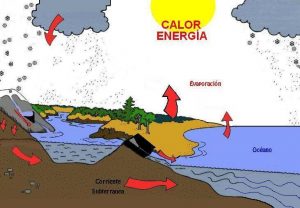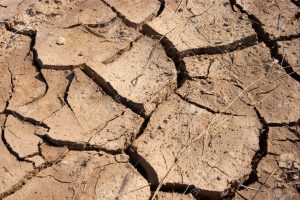The rain, synonymous with life and joy for many people, for a couple of others a miracle, because perhaps in the places where they live it is unusual to see a drop of water fall from the sky, the rain phenomenon It is a very important factor for the life cycles of planet Earth. Let it rain talks about the very cycle of water in our atmosphere.
For the phenomenon of rain to exist or be generated, it is important to start with what causes it, the water, one of the biomolecules most important on our planet, purposely forming 70 percent of our terrestrial composition. And not surprisingly, 75 percent of our body is made up of it.
So it is not surprising that for the human being to understand the phenomenon of rain is essential, since it is the natural route that water carries out, even in the different states of matter that we know.
Water is made up of 2 hydrogen atoms (H) and 1 oxygen atom (O) linked by two covalent bonds, so that the molecule has a flat triangular shape, graphed in this way H20. That is, the hydrogen and oxygen atoms are separated from each other by approximately 0,96 Angstroms (more or less one nanometer – one billionth of a meter) and the angle formed by their bond lines is about 104,45 degrees.

Rain is an essential meteorological process for life
What is the process of the phenomenon of rain
According to the official conceptualization of the World Meteorological Organization, rain is the precipitation of liquid particles of water, of approximately a diameter greater than 0,5 mm or of smaller drops, but very dispersed. If it does not reach the earth's surface, it would not be rain, but virga, and, if the diameter is smaller, it would therefore be a drizzle. Rain is measured in cubic millimeters par excellence and there are various instruments for it.
The phenomenon of rain essentially depends of three factors: atmospheric pressure, temperature and, especially, atmospheric humidity.
The water evaporated by the sun from lakes, rivers and seas can return to the earth, in addition, in form of snow or hail. Depending on the surface it hits, the sound it will produce will be different. As we said before regarding the states of matter.
Rain is one of the most common environmental phenomena and at the same time the most surprising, even within its simplicity. The rise of water in a gaseous state is one of the main steps for rain. Clouds They are made up of an infinity of water droplets, so small that in a cubic centimeter there is an average of 500.
After the water vapor forms the clouds, the condensation process takes place, which is a thermal shock that makes the water go from its gaseous state to liquid, promoting the union of its molecules, so that precipitation is subsequently generated.
The water removed from the earth by evaporation is thus restored to the state liquid in seas, in rivers, in lakes: in this way the so-called water cycle is completed.

The so-called water cycle
From all the above, it is logical to say that there are clouds in which the droplets stay small, and for this reason they remain suspended in the sky, while in a few other clouds the droplets enlarge, transforming into downpours, which, added to other atmospheric conditions, are called storms.
Learn more about the topic here: WHAT IS THE GRAVITY OF THE PLANETS THAT MAKE UP OUR SOLAR SYSTEM?
Elements necessary to carry out the phenomenon of rain
Atmospheric pressure
It is understood as the force per unit area that the air exerts on the surface of the Earth. Atmospheric pressure at a point it coincides numerically with the weight of a static column of air in a unitary straight line that extends from that point to the upper limit of the atmosphere, this from an exemplified point of view.
Temperature
Room temperature represents the range in which the air feels neither too cold nor too hot when wearing loungewear. This range is between 150.000 ° C and 300.000 ° C and it is the range to regulate the temperature offered by climate control devices. Variation in these data results in the evaporation of water on the Earth's surface.
atmospheric humidity
As we have said before, the air contains variable amounts of water, in the form of vapor, this is known as atmospheric humidity. The humidity of the air is vapor concentration of water in the air, in other words, the amount, or number of molecules, of water vapor per unit volume of air.
This unit can range from 0 to 4% by volume. This wide variation is due to water can appear, at the usual temperatures of the planet in the three states of matter, solid, liquid and gas, since it interacts with the internal energies of the Earth.
Read more about the topic here: 7 PLANETS FOUND SIMILAR TO EARTH. HOPE FOR HUMANITY?
Places in the world where the phenomenon of rain is not common

Places where it hardly ever rains
Most we live in a climate in which rain, to a greater or lesser extent, is present. However, there are places in the world where it never rains, the earth shakes and people have learned new ways of subsisting, not in a referential way with water.
Wādī Ḥalfā in Sudan
To the north of Sudan shores of Lake Nubia, this small town receives only 2.45 milliliters of water per year, thus being the sunniest place on the planet with 4 hours of sunshine per year. In this locality, summers are usually long and oppressive, reaching temperatures that exceed 300º C.
Ica in Peru
The city of Ica is one of the most famous places in Latin America in southern Peru, thanks to its border location with the Chilean area of the Atacama desert or attractions such as the oasis of Huacachina and the beaches from Paracas. It has its own ecosystem conditioned by the 2.29 millimeters of water that fall each year and a summer that lasts from December to March. Strangely, this was a place where thousands of years ago, colonies of penguins crowded together under not-so-extreme conditions.
Read more about it here: WHAT IS THE FIRST COMPOSED PLANET IN OUR UNIVERSE?
Luxor in Egypt
The city of Luxor, the glorious city located in the south of Egypt, the recorded amount of water that falls annually is 0.862 milliliters. And this when it rains product of tail blows strong climatic conditions of other regions, since Luxor is one of the driest places in the world, there can be pauses of up to 6 years without the occurrence of the rain phenomenon. The temperature of this city is more than 40º C during the summer months, Luxor is curiously one of the places that registers the greatest difference in temperature between night and day with marks of up to 16º C of contrast.
Kufra in Libya
With 0.860 milliliters of water per year, Kufra is considered as the driest spot in africa. A desolate scene famous for the agricultural project sustained by water from an underground aquifer, the only way to subsist in this place is through plots of crops that form green dots, also famous for being visible from space.